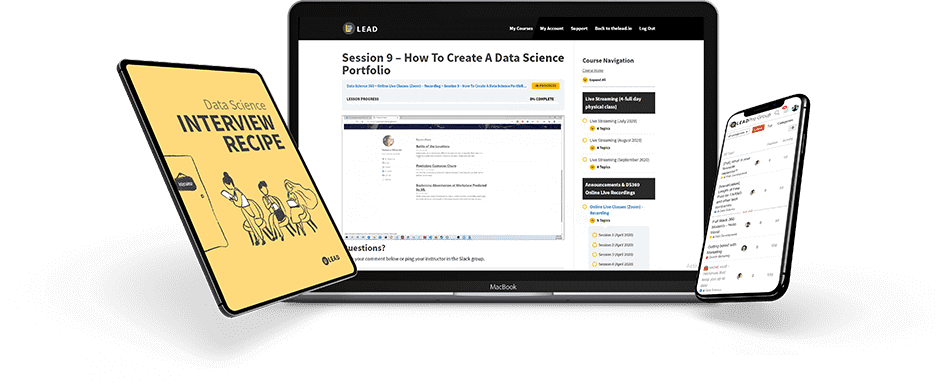Need to hire the ultimate data science candidate?
Do you have a game plan?
Well, just in case you don’t, we got you!
We get it hiring is a hard process.
You need to go through multiple candidates and be able to pick up the best one.

More often than not, we focus on the candidate’s performance in an interview, but what about the interviewers?
Interviewers are just as integral in the hiring process and so is their preparation.
Here’s our guide on how to prepare when hiring your data science candidate:
Step 1: Do your research.

This entails figuring out what your company needs in the position you’re hiring for in terms of:
-
Soft skills
Can they handle feedback?
What do they do with difficult projects? Can they ask for help?
Do they have trouble with group projects?
Can they handle tasks and projects without guidance?
-
Attitude
Do they have an energy that you think would work well with the current team?
Are they confident and passionate about their work?
Are they self-starters or good at working under a manager?
Do they have an attitude that matches that of your company?
-
Expectations
How do they expect to grow with your company?
What is their salary expectation?
Do they have long term goals that your company may not be able to allow?
-
Technical Skills
When it comes to technical skills, especially when hiring a data science candidate,
Step 2: Ask the right questions.

In order to extract the specific information, you need from such a large array of candidates you need to have a list of standardised questions for your Data Science applicants.
Include skills that you or the manager of the position think are integral to the position and those that can be learnt on the job.
Here are some questions we think you need to ask, among the sea of em (handpicked from The Data Science Interview Recipe):
(Q1) Is false positive or false negative a more severe problem?
Why?
(A) False positive and false negative are two types of error in binary classification.
A false positive is a test result that incorrectly indicates the presence of a condition.
On the other hand, a false negative is an error where the test result incorrectly fails to indicate the presence of a condition, when it is actually present.
The severity of the error depends on the context and field of application.
In some fields, both false positive and false negative should be avoided.
(Why) It’s essential for your Data Science candidate to know the why.
What we’re looking for here is if they know how to apply the information that they may have just memorized.
Data Science skills are nothing without application.
(Q2) Which of the following machine learning algorithms can be used for inputting missing values of both categorical and continuous variables?
a) K-means clustering
b) Linear regression
c) K-NN (k-nearest neighbour)
d)Logistic regression
(A) The answer is the K nearest neighbour (K-NN).
(W) What you, as an interviewer, are trying to find out from this question is your Data Science candidate’s understanding of the best practices to handle missing data.
Most machine learning algorithms do not like missing data, so we should handle them properly.
It is a good practice to identify and replace missing values for each column in our missing data before we perform modelling.
(Q3) What is selection bias?
Why is it important?
How can we avoid it?
(A) Bias is common in data science, especially in dealing with large data sets.
Bias refers to the available data failing to represent the population or observation of a study.
In other words, the data does not capture what we want to predict, or it may lead to results that are unfair against a group of people.
Selection bias is important because bias data produces bias models that can be discriminatory and harmful in most cases.
Avoiding non-random samples is the best way to deal with bias.
While non-random samples are impractical, apply techniques such as resampling, boosting, and weighting to help deal with the situation.
(W) This question is imperative to make sure your data science findings from this particular candidate will actually be usable, accurate, and trustworthy.
It’s the fastest way to check if your candidate shares your values in data.
Do these questions sound nothing like the ones you’ve got on hand?
It’s alright, we’ve made a lil cheat sheet for you.
Yes, it works even if you know nothing about Data Science (we’ve got the q’s and a’s all in one pdf).
We recommend downloading The Data Science Interview Recipe for an exhaustive array of recommended questions you can and, honestly, probably should ask your candidates.
Step 3: Fix your attitude.

A lot of the time, when candidates perform badly in interviews, despite having a shining resume- it’s because they got extremely nervous.
You can help your applicant feel more comfortable by embodying that attitude yourself.
Tip #1: Open body language.
Avoid folding your arms or crossing your legs.
By opening your body up to the next person you are creating a more welcoming and relaxed environment.
Tip #2: Tone
Try to sound as relaxed and confident as possible.
By showing that you are calm you are able to exude that energy into the candidate.
It helps both of you have a more genuine and effective conversation.
By using these steps, we are certain that you will be able to find the right fit for the department you are hiring for.
What now?
Double-check your list of question against The Data Science Interview Recipe!

The Data Science Interview Recipe focuses on key questions (and the right answers!) to ask your candidates to ensure you find the right fit.
Download it to change the way you interview today.
And if you’re an interviewee, have a sneaky look at the interview questions you might just get asked in your next interview.
For a more in-depth guide on how to smash your next interview read: 4 Tips To Nail Your Data Science Interview


0 Comments